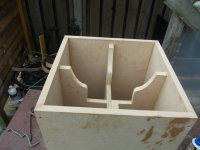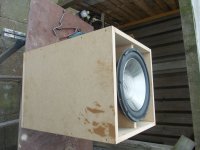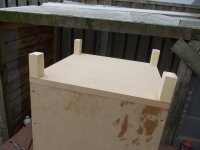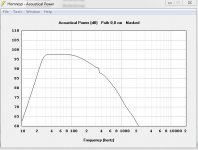Seems like a lot of people end up there. <snip>
It seems to me that cardioid/dipole make more sense in the next region up, ie upper bass/lower midrange. You can’t really spread out sources there, but room modes still aren’t dense enough to be in the statistical region.
It seems to me that cardioid/dipole make more sense in the next region up, ie upper bass/lower midrange. You can’t really spread out sources there, but room modes still aren’t dense enough to be in the statistical region.
What happens if you spread out sources in the upper bass/lower midrange?
What happens if you spread out sources in the upper bass/lower midrange?
You hear them where you put them. For example, mount a driver playing up to 300 or 400 Hz behind you to the right, and you'll hear it there.
You hear them where you put them. For example, mount a driver playing up to 300 or 400 Hz behind you to the right, and you'll hear it there.
OK. I wasn't sure if our perception locates on a certain frequency range or not. For example, if you locate a 400Hz driver to your back right but then mid/upper mids at standard front axis locations.
Or, what if you flipped it? Placed low mids on front axis and mid-upper-mids around the room. Does a frequency range dominate our location perception so we locate on that position?
I can't think of a practical reason why someone would want to do that but it would be good to understand.
OK. I wasn't sure if our perception locates on a certain frequency range or not. For example, if you locate a 400Hz driver to your back right but then mid/upper mids at standard front axis locations.
Our localization capability will peak in the 1-3 kHz range and it falls to either side. By the modal range in a small room there is little to no localization. Of course if you play a single tone, you will likely localize it no matter the frequency, but for complex signals with lots of frequency content, the HFs will override the lows in location perception.
It seems to me that cardioid/dipole make more sense in the next region up, ie upper bass/lower midrange. You can’t really spread out sources there, but room modes still aren’t dense enough to be in the statistical region.
Isn't this exactly what D&D do?
Cardioid low mids, so the 100Hz to 500Hz range is more flat at the listeners ears.
Then add multiple subs and you have "flat" sound from 20-20kHz.
In portable PA, cardioid subs can be useful.
There you often can't use multiple subs.
Edit: And spl levels often are a limit.
so the 100Hz to 500Hz range is more flat at the listeners ears.
Why would that be?
That's the received wisdom, but it's usually not true. I've done quite a lot of testing that shows it's something of a myth.By the modal range in a small room there is little to no localization.
In testing I have found single pure tones to be difficult to locate, no matter the frequency. Band limited noise is much easier. Agree that the HFs can steer location perception (they are the most noticeable), but they mostly don't obscure bass if it's there.Of course if you play a single tone, you will likely localize it no matter the frequency, but for complex signals with lots of frequency content, the HFs will override the lows in location perception.
Started with the closed box with a 12 inch, later the dipole with 2 x wsp26s visaton, these did well in a dipole in past, did let the doors rattle with it, clean bass.
This closed box is a version who fires on the floor.
This closed box is a version who fires on the floor.
Attachments
Started with the closed box with a 12 inch, later the dipole with 2 x wsp26s visaton, these did well in a dipole in past, did let the doors rattle with it, clean bass.
This closed box is a version who fires on the floor.
I want to put in bassreflex pipes, however, where I do set the output because next to the speaker is no room, only on top, or sides, somewhone?
I do need some sub amp and correction, but this is not a problem.
I aks david, author of hornresp also.
regards
Attachments
- Status
- This old topic is closed. If you want to reopen this topic, contact a moderator using the "Report Post" button.
- Home
- Loudspeakers
- Multi-Way
- Cardioid Bass.... yes, very good!!



